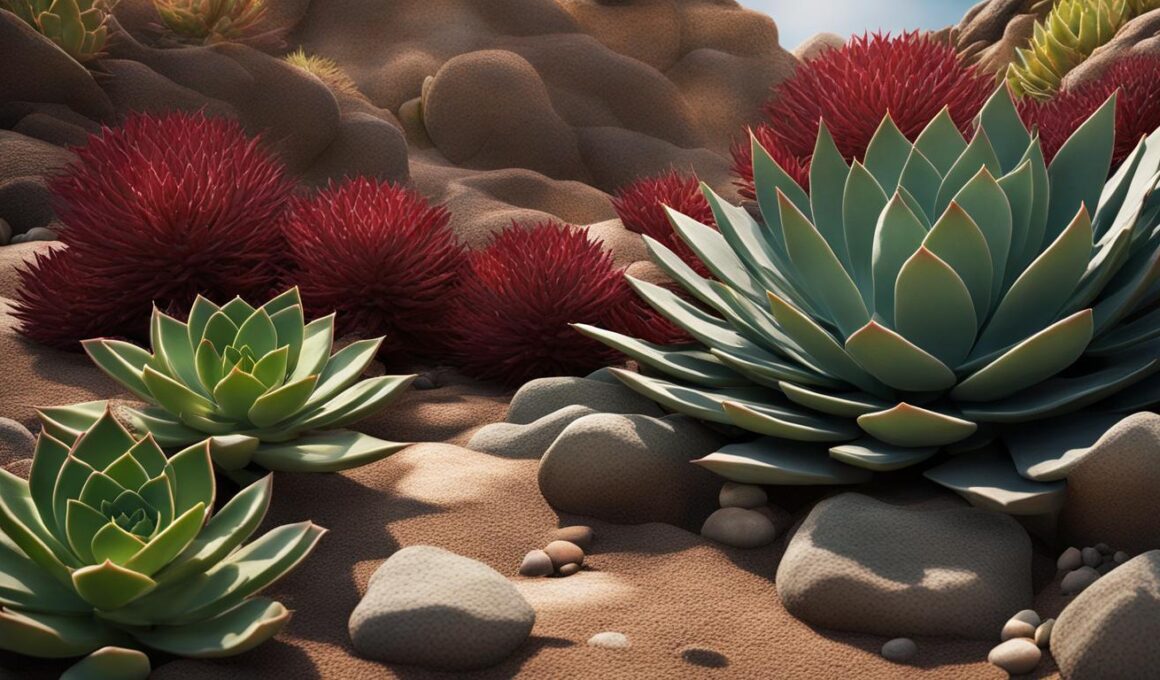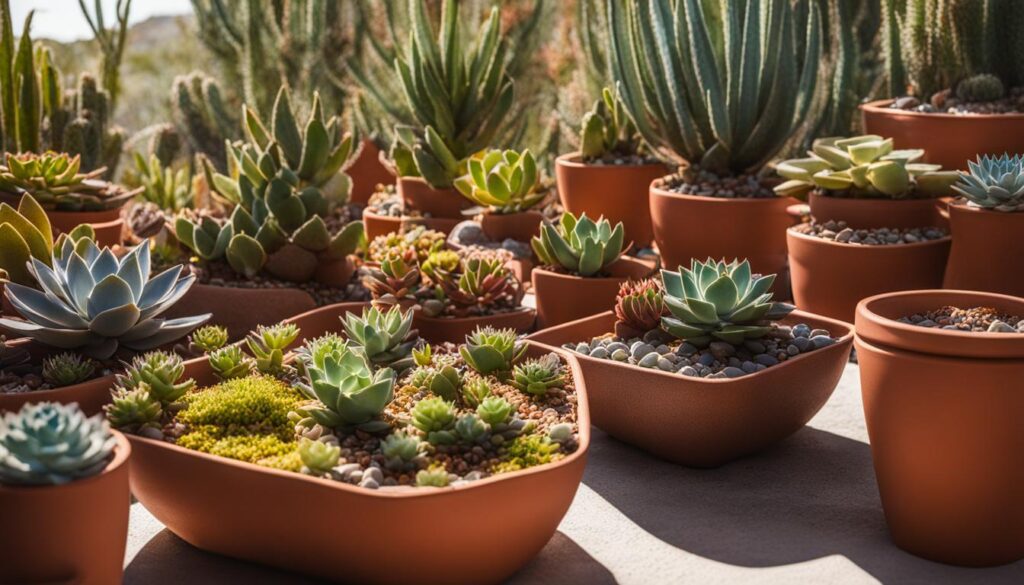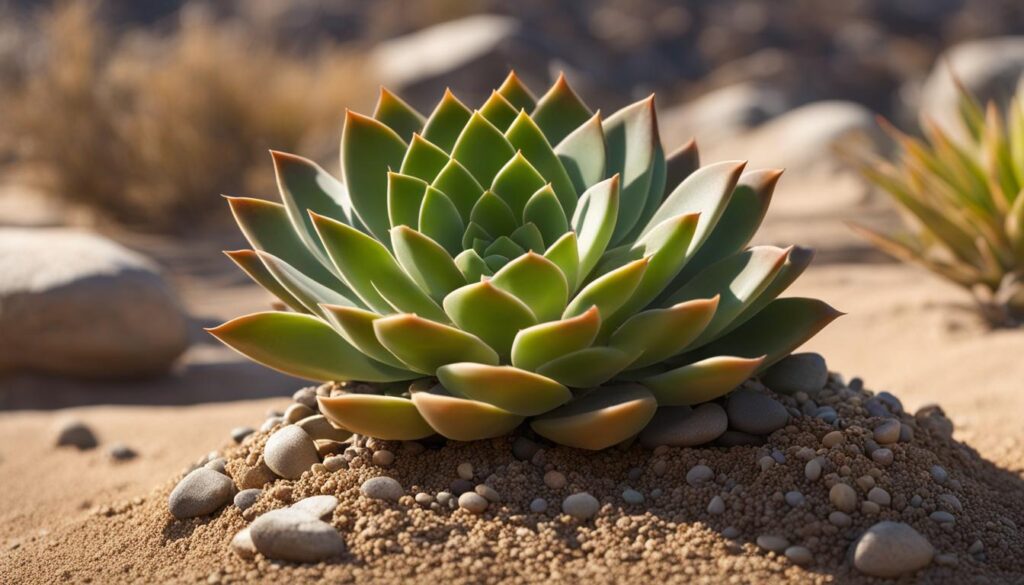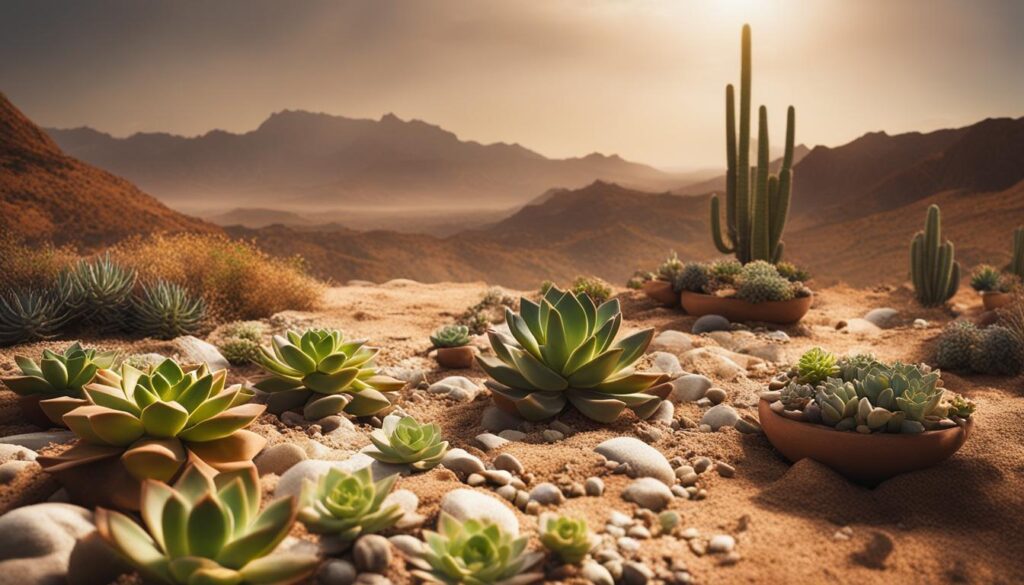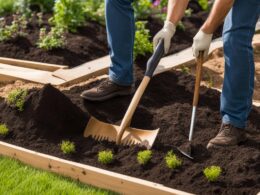Hardy succulents are becoming increasingly popular for their striking appearance and ability to thrive in dry landscapes. From cacti to echeverias, these resilient plants offer endless diversity in shape and form. Whether you’re looking to enhance your front yard or create a living jewelry piece, there are a variety of drought-tolerant succulents to choose from. In this article, we will explore some of the top picks for hardy succulents that can withstand drought-prone areas.
Key Takeaways:
- Hardy succulents are excellent choices for dry landscapes.
- They come in various shapes and forms, adding visual interest to your garden.
- These plants can thrive in drought-prone areas due to their ability to store water.
- By incorporating hardy succulents in your landscaping, you can create a beautiful and low-maintenance garden.
- With a wide selection of hardy succulents available, you can find the perfect plants for your specific climate and design preferences.
7 Drought Tolerant Succulents for Beginners
If you’re new to succulent gardening, it’s best to start with varieties that are known to be easy to grow and maintain. Here are seven beginner-friendly drought-tolerant succulents that are proven performers:
| Succulent Name | Watering Frequency | Light Requirements |
|---|---|---|
| Echeveria | Every 2-3 weeks | Full sun to partial shade |
| Sedum | Every 2-3 weeks | Full sun |
| Aloe Vera | Every 2-3 weeks | Full sun |
| Haworthia | Every 2-3 weeks | Bright indirect light |
| Agave | Every 3-4 weeks | Full sun |
| Kalanchoe | Every 2-3 weeks | Bright indirect light |
| Crassula | Every 1-2 weeks | Full sun |
These succulents have adapted to survive in harsh conditions, making them perfect for beginner gardeners looking to add a touch of green to their space. They require minimal watering and can tolerate prolonged periods of drought, making them ideal for those who may forget to water their plants regularly.
When choosing drought-tolerant succulents for beginners, it’s important to consider their light requirements as well. Most of these varieties thrive in full sun, but some can also tolerate bright indirect light. Placing your succulents in the right spot will ensure their healthy growth and vibrant colors.
Remember to provide adequate drainage for your succulents by using well-draining soil and pots with drainage holes. This will prevent overwatering and root rot, which can be detrimental to the health of your plants. With these easy-to-grow succulents, you’ll be able to create a stunning and low-maintenance garden even if you’re a beginner.
Succulent Watering Needs
Succulents are naturally adapted to harsh environments and have developed mechanisms to store and conserve water. Their leaves and stems are designed to store water from infrequent rainfall, minimizing water loss. This means that succulents can go without water for extended periods, making them ideal for drought-prone areas. In fact, they can even thrive during summer droughts when other plants wither. Their water-wise adaptations make them low-maintenance and perfect for busy gardeners.
Understanding the watering needs of succulents is crucial for their survival and proper growth. While they can survive with minimal watering, it’s important to strike the right balance to avoid overwatering or underwatering. Overwatering can lead to root rot and other problems, while underwatering can cause dehydration and stunted growth.
So how often should you water your succulents? The frequency of watering will depend on factors such as the type of succulent, the climate you live in, and the time of year. As a general rule, it’s best to water your succulents thoroughly but infrequently. Allow the soil to dry out completely between waterings, as succulents prefer dry conditions. It’s better to underwater than to overwater, as succulents are more tolerant of drought than excess moisture.
Signs of Overwatering and Underwatering
Overwatering succulents can lead to root rot, which is a common problem in succulent care. Signs of overwatering include yellowing or wilting leaves, soft or mushy stems, and a foul odor coming from the soil. If you notice any of these signs, it’s important to adjust your watering routine and allow the soil to dry out before watering again.
On the other hand, underwatering can result in shriveled or wrinkled leaves, slow growth, and leaf drop. If your succulents show these symptoms, it’s a sign that they need more water. However, it’s important not to overcompensate and water them too much, as this can also cause problems.
Observation is key when it comes to watering succulents. Get to know your plants and their individual needs. Pay attention to the soil moisture levels and the appearance of your succulents. With time and practice, you’ll develop a watering routine that works best for your succulent collection.
| Type of Succulent | Watering Needs |
|---|---|
| Echeveria | Water sparingly, allowing the soil to dry out completely between waterings. |
| Aloe Vera | Water deeply but infrequently, allowing the soil to dry out between waterings. |
| Haworthia | Water moderately, allowing the top inch of soil to dry out between waterings. |
| Sedum | Water sparingly, allowing the soil to dry out completely between waterings. |
| Agave | Water deeply but infrequently, allowing the soil to dry out between waterings. |
Remember, it’s better to underwater your succulents than to overwater them. These water-wise plants have adapted to survive in dry conditions, so they can tolerate periods of drought. By providing them with the right amount of water and allowing the soil to dry out between waterings, you’ll help them thrive in your drought-prone garden.
Best Soil for Succulents: Ensuring Well-Draining Soil for Thriving Plants
When it comes to growing succulents, one of the most crucial factors to consider is the type of soil you use. Succulents thrive in well-draining soil that mimics their natural habitat, allowing excess water to quickly drain away. In this section, we will explore the best soil options for succulents to ensure their health and long-term success in your garden.
While there are various opinions on the perfect soil mix for succulents, most experts agree that a commercial mix made specifically for succulents and cacti is a suitable choice. These pre-packaged mixes are typically formulated to provide the ideal balance between water retention and drainage, ensuring that your succulents receive the right amount of moisture without risking root rot.
Adding porous materials such as perlite, pumice, or sand to the soil mix can further improve drainage. These materials not only enhance water movement within the soil but also prevent compaction, allowing air to reach the roots. A well-aerated root system is essential for the overall health and vitality of succulents. It’s important to note that while these amendments can improve drainage, excessive amounts may lead to overly fast drying of the soil, requiring more frequent watering.
The Benefits of Well-Draining Soil for Succulents
Well-draining soil is essential for succulents due to their unique water storage capabilities. Their leaves and stems are designed to retain water during periods of rainfall and release it gradually to sustain the plant during drier times. In their natural habitat, succulents are often found in rocky or sandy soils, where water drains away quickly. Replicating these conditions in your garden will help mimic their natural environment and support healthy growth.
By providing well-draining soil for your succulents, you can prevent issues such as root rot and mold growth, which can occur when excess water lingers around the roots. These problems can lead to the deterioration of the plant’s health and, in severe cases, even death. Ensuring proper drainage is vital for succulents to thrive and maintain their resilience in drought-prone areas.
To summarize, choosing the right soil mix and ensuring proper drainage are essential for the successful cultivation of succulents. Use a commercial succulent/cacti mix as a base, and enhance it with porous materials like perlite or pumice to improve drainage. Remember to strike a balance between drainage and water retention, as succulents can also suffer from under-watering. With the right soil and care, your succulents will reward you with their unique beauty and ability to thrive in challenging environments.
Designing With Drought Tolerant Succulents
Succulents not only offer a water-wise solution for your garden but also provide endless possibilities for creative and visually appealing designs. Whether you have a small balcony, a rooftop, or a spacious yard, you can incorporate succulents in various landscaping scenarios to enhance your outdoor space. From ground covers to living walls, succulents can transform any area into a unique and low-maintenance oasis.
Ground Covers
One of the most popular ways to use succulents is as ground covers. These low-growing plants spread and create a dense carpet-like effect, adding texture and color to your landscape. Sedums, such as Sedum spurium and Sedum album, are excellent choices for ground covers due to their ability to withstand drought conditions and their ability to grow and fill empty spaces quickly. Mix different succulent varieties to create a visually interesting tapestry of colors and forms.
Vertical Gardens
If you have limited space or want to make a statement with your succulents, vertical gardens are the way to go. Succulents’ shallow roots and ability to store water make them well-suited for vertical growth. You can create living walls using vertical planters or repurpose wooden pallets to showcase your favorite succulents. Some popular vertical garden succulents include Sempervivum, Crassula ovata (Jade Plant), and Echeveria elegans.
Unconventional Containers
Unleash your creativity by planting succulents in unconventional containers. Anything from vintage teacups to seashells can become a unique home for your succulents. Upcycling items like old birdcages, toy trucks, or ceramic boots can add a whimsical touch to your outdoor space. Just ensure that the containers have drainage holes or layer the bottom with pebbles to prevent waterlogging and root rot.
Terrariums
Terrariums provide a controlled environment for your succulents and can be an excellent choice for those who want to bring these plants indoors or have limited outdoor space. Choose an open or closed terrarium depending on the humidity and light requirements of your succulents. Layer the bottom with rocks or activated charcoal for drainage, add a well-draining succulent soil mix, and carefully arrange your succulents. Popular terrarium succulents include Haworthia, Aloe aristata, and Crassula muscosa.
10 Easy Succulents for Your Drought-Tolerant Garden
If you’re looking to create a beautiful and low-maintenance garden that can withstand dry conditions, incorporating easy succulents is the perfect solution. These hardy plants have adapted to survive in arid environments, making them ideal for drought-prone areas. Here are ten easy-to-grow succulents that will thrive in your drought-tolerant garden:
| Succulent | Common Name | Watering Needs | Light Requirements |
|---|---|---|---|
| Echeveria | Hens and Chicks | Low water requirements | Full sun |
| Sedum spurium | Dragon’s Blood Stonecrop | Drought-tolerant | Full sun to partial shade |
| Jade Plant | Crassula ovata | Infrequent watering | Partial sun to bright light |
| Aloe vera | Medicinal Aloe | Low water requirements | Full sun to partial shade |
| Agave | Century Plant | Drought-tolerant | Full sun |
| Kalanchoe | Flaming Katy | Low water requirements | Partial sun to bright light |
| Graptopetalum | Graptoveria | Infrequent watering | Partial sun to bright light |
| Sempervivum | Hens and Chicks | Drought-tolerant | Full sun to partial shade |
| Crassula perforata | String of Buttons | Low water requirements | Bright indirect light |
| Euphorbia tirucalli | Pencil Cactus | Drought-tolerant | Full sun to partial shade |
These easy succulents will not only add beauty to your garden, but they will also require minimal maintenance. Place them in well-draining soil and provide adequate sunlight, and they will thrive with infrequent watering. Whether you’re a seasoned gardener or a beginner, these drought-tolerant succulents are the perfect choice for creating a stunning and sustainable landscape.
Remember to always check the specific care requirements for each succulent to ensure optimal growth. With their resilience and captivating forms, these easy succulents will transform your drought-tolerant garden into a thriving oasis of beauty.
Why Choose Easy Succulents for Your Drought-Tolerant Garden?
Easy succulents are not only visually appealing, but they also offer several benefits for your drought-tolerant garden. Here are a few reasons why you should consider incorporating them into your landscape:
- Drought tolerance: These succulents have evolved to store water in their leaves and stems, allowing them to survive in dry conditions with minimal watering.
- Low maintenance: Easy succulents require little attention and care. They can thrive with infrequent watering and minimal fertilization.
- Wide variety: There is a diverse range of easy succulents to choose from, each offering unique shapes, colors, and textures. This allows you to create a visually interesting and personalized garden.
- Versatility: Easy succulents can be planted in various ways, including containers, hanging baskets, or as ground cover. They can also be combined with other drought-tolerant plants to create stunning displays.
- Environmental benefits: By choosing easy succulents for your garden, you contribute to water conservation efforts. These plants require less water compared to traditional garden plants, helping to reduce water usage and promote sustainability.
With their striking beauty, resilience, and environmental advantages, easy succulents are an excellent choice for anyone looking to create a stunning and sustainable drought-tolerant garden.
Conclusion
In conclusion, hardy succulents are the perfect choice for drought-prone areas. Their ability to store water and thrive in harsh conditions makes them low-maintenance and ideal for busy gardeners like you. Whether you opt for hens and chicks or echeverias, there is a wide variety of options available to enhance your dry landscape.
By incorporating these water-wise plants into your garden, you can create visually stunning and environmentally friendly landscapes. The adaptability of succulents allows for endless design possibilities, from ground covers to vertical gardens. Their resilience and low water needs make them a smart choice for water-conscious gardeners looking to maximize their garden space.
Embrace the world of hardy succulents and transform your drought-prone garden into a vibrant oasis. With their striking appearance and ability to withstand harsh conditions, these resilient plants are the perfect addition to any landscape. So go ahead, discover the beauty and practicality of hardy succulents and create a sustainable outdoor haven for yourself!
FAQ
What makes succulents ideal for drought-prone areas?
Succulents have natural adaptations that allow them to store and conserve water, making them able to go without water for extended periods. Their ability to thrive in harsh conditions makes them low-maintenance and perfect for drought-prone areas.
What kind of soil do succulents require?
Succulents thrive in well-draining soil that mimics their natural habitat. It’s recommended to use a commercial mix made specifically for succulents and cacti. Regular potting soil should be avoided, as it tends to retain too much moisture and can lead to root rot. Adding porous materials like perlite, pumice, or sand can improve drainage.
How can succulents be incorporated into landscaping?
Succulents offer endless possibilities for design and water conservation. They can be used as ground covers, focal points, or in unconventional containers like seashells or toy trucks. They thrive in terrariums as long as there is proper drainage. Succulents are also perfect for creating green roofs, vertical gardens, and stunning living walls.
What are some easy-to-grow succulents for drought-tolerant gardens?
Here are ten additional options: [List of ten succulents]





